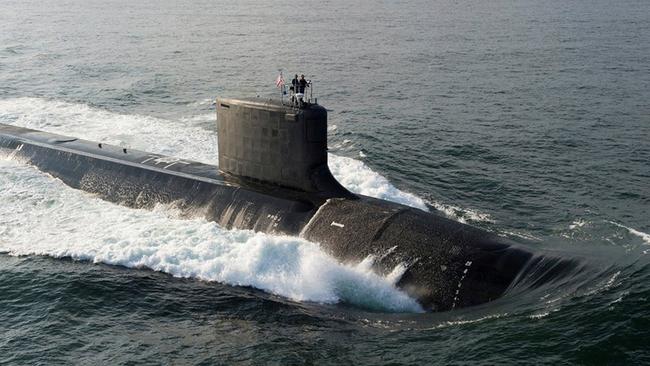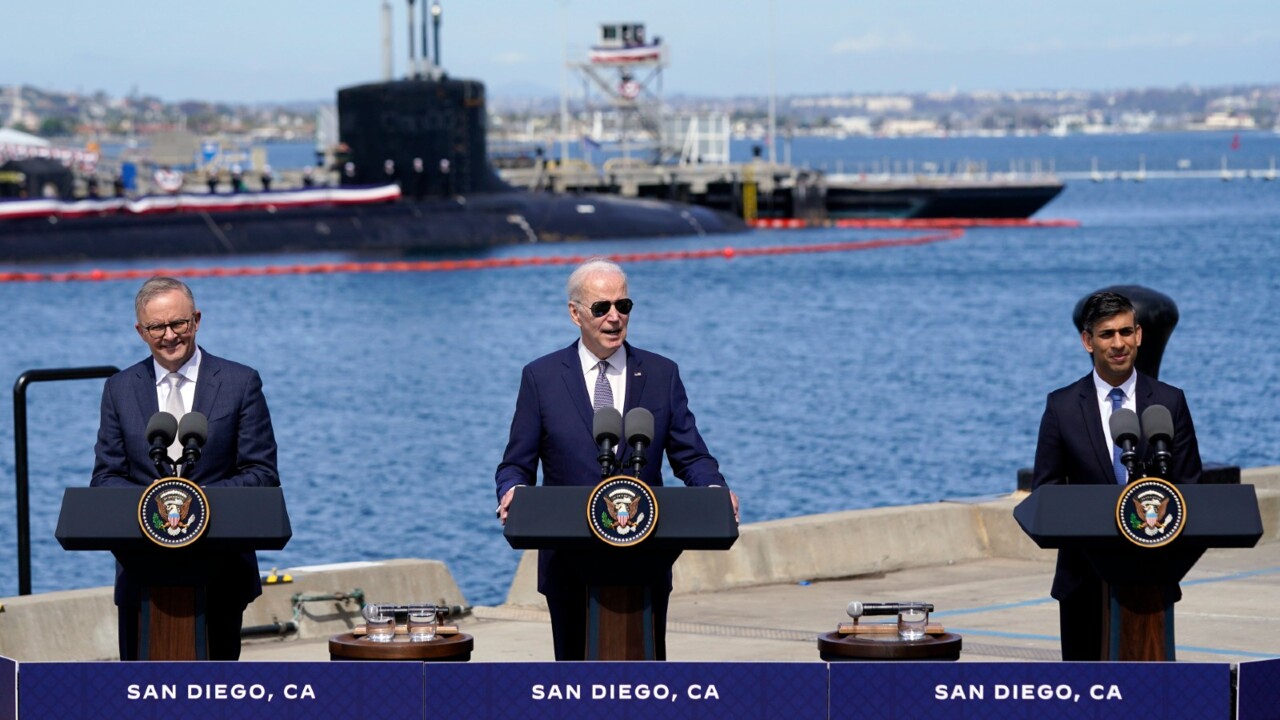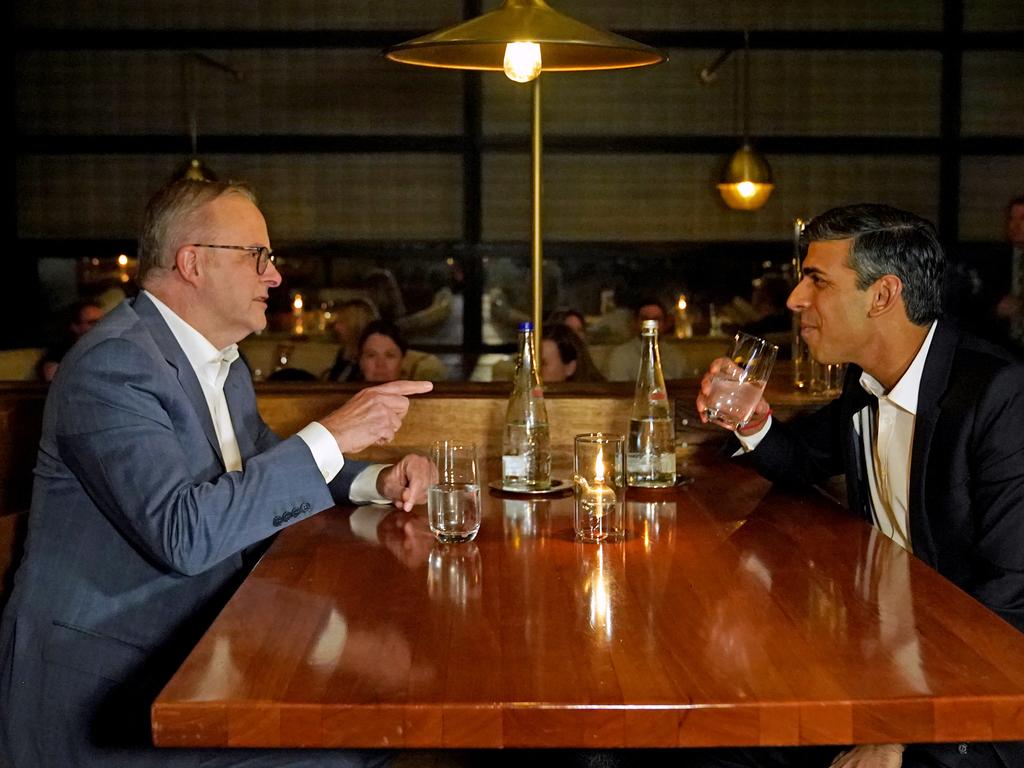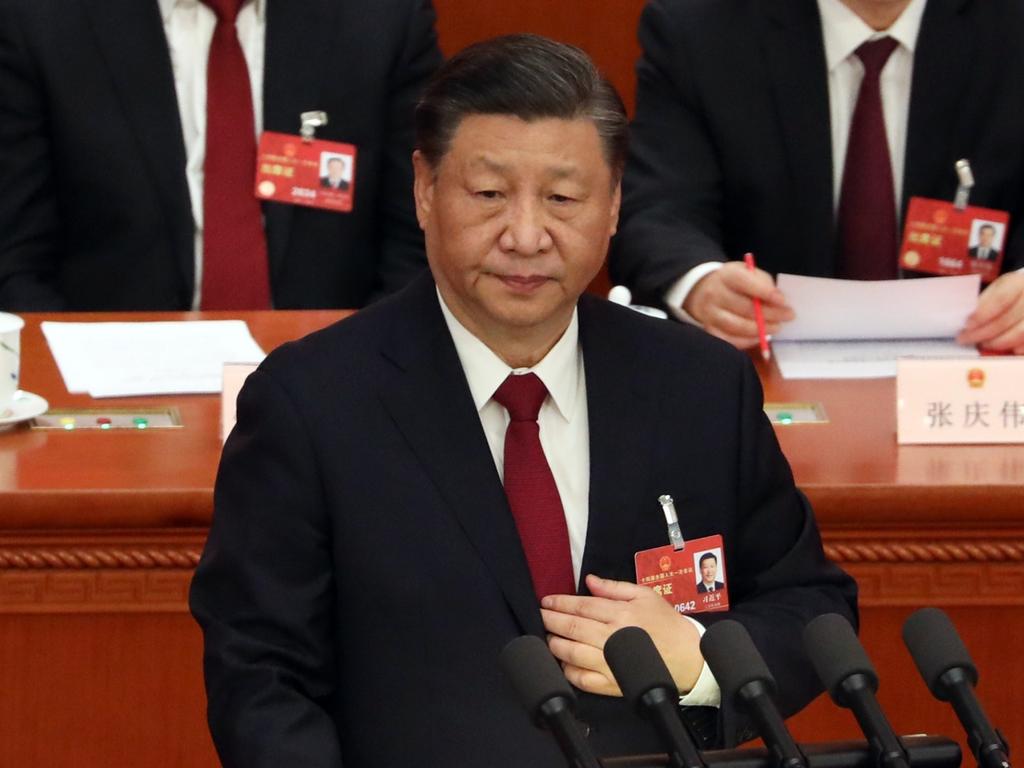Eight nuclear-powered submarines to be built in Adelaide under $368bn AUKUS deal
The nuclear-powered submarines will be built in Adelaide — the first to be finished by 2042 — with launch systems to fire cruise missiles.

Australia’s journey to acquiring nuclear submarines will cost $268bn to $368bn out to the mid-2050, but the massive endeavour won’t begin to drive up defence spending for another four years.
Under the “optimal pathway” revealed today by Anthony Albanese, Joe Biden and British Prime Minister Rishi Sunak, eight AUKUS-class submarines – based on a British design – will be built in Adelaide, with the first to be completed by 2042.
An estimated 20,000 direct jobs will be created in Australia by the AUKUS pathway – with the bulk of the jobs in South Australia and Western Australia – to build the submarines and new infrastructure.

In the interim, Australia will buy three US-made Virginia-class subs with an option of two more, with the first arriving in 2033. But the sale still requires congressional approval.
Up to five nuclear submarines – four US and one British – will begin rotational deployments to operate from Australia from 2027.
The US will start to lift the tempo of its nuclear submarine visits to Australia from 2023, with Australian crew members training on board the boats.
The delivery schedule may mean planned life-extending upgrades will not be required for all six of the navy’s existing Collins-class submarines, but the government will decide that once the nuclear sub acquisition is underway.
Like the Virginia-class subs, the Australian-built AUKUS-class boats will have vertical launch tubes, enabling them to fire Tomahawk cruise missiles on ships and land targets at ranges of 1500km.
The joint leaders’ statement said the submarine partnership would “promote a free and open Indo-Pacific that is secure and stable”.
They said the plan would ensure “the highest nuclear non-proliferation standard”, and all three nations would consult with the International Atomic Energy Agency to develop an approach “that sets the strongest possible precedent” for the acquisition of nuclear-powered subs.

The plan would also require “robust, novel information sharing and technology co-operation”, they said, and require the industrial bases of all three nations to be integrated as never before.
It will support 4000 to 5000 direct jobs in Adelaide, plus another 4000 workers to design and build the infrastructure. Another 3000 direct jobs are expected to be created in Western Australia.
“This plan is designed to support Australia’s development of the infrastructure, technical capabilities, industry and human capital necessary to produce, maintain, operate and steward a sovereign fleet of conventionally-armed nuclear-powered submarines,” the AUKUS leaders’ statement said.
It declared Australia was “fully committed to responsible stewardship of naval nuclear propulsion technology”.
Australian servicemen, engineers and others will embed with the US and British Royal Navy from as early as this year in nuclear submarines and maritime bases to learn how to operate and build the AUKUS boats.
The Prime Minister, Mr Biden and Mr Sunak said in a joint statement that the AUKUS pathway would elevate the industrial capacity of all three countries and expand their presence in the Indo-Pacific.
“Implementing AUKUS will also require robust, novel information sharing and technology co-operation,” the three leaders said.
“Our nations are committed to further trilateral collaboration that will strengthen our joint capabilities, enhance our information and technology sharing, and integrate our industrial bases and supply chains while strengthening the security regimes of each nation.
“For more than a century, our three nations have stood shoulder to shoulder, along with other allies and partners, to help sustain peace, stability, and prosperity around the world, including in the Indo-Pacific … The steps we are announcing today will help us to advance these mutually beneficial objectives in the decades to come.”
Mr Sunak also reflected on the words of US President John F Kennedy more than 60 years ago when he spoke of working for a “higher purpose: the maintenance of freedom, peace and security”.
“Today we stand together, united by that same purpose, and recognising that to fulfil it, we must forge new kinds of relationships to meet a new kind of challenge, just as we have always done,” he said.
“In the last 18 months the challenge we face has only grown. Russia’s illegal invasion of Ukraine, China’s growing assertiveness, the destabilising behaviour of Iran and North Korea ... all threaten to create a world defined by danger, disorder and division.
“Faced with this new reality, it’s more important than ever we strengthen the resilience of our own countries.”
For Australia, defence spending will have to rise by at least 0.15 per cent of GDP from 2026-27 to pay for the program, on top of the already-forecast Defence budget of about 2.2 per cent by the end of the decade.
The cost of the plan will hit the May budget, at $9bn over the forward estimates. This will be offset by $6bn that had been allocated to the now-cancelled Attack-class submarine program, and a further $3bn in savings from the wider Defence budget, to be detailed in the upcoming defence strategic review.
The forecast costs are in “out-turned dollars” that account for inflation, include the cost of sustaining and operating all of the subs, and include a large contingency. The government isn’t disclosing how much the Virginia-class submarines will cost, but Australian taxpayers will invest almost $3bn over the next four years to assist US submarine production.
The nuclear reactors for all of the vessels will welded shut and will not require refuelling over their service life.
But Australia has committed to managing all radioactive waste generated through its nuclear-propelled submarine program, including spent nuclear fuel, on Australian soil.
The US is examining what additional costs may be required.

The three leaders met in a gymnasium in Naval Base Point Loma in San Diego, but the media was only granted access to the area for a matter of 20 seconds before being moved on once questions were directed to President Biden.
Mr Albanese declared Australia would develop a sovereign submarine capability “commanded by the Royal Australian Navy and sustained by Australians in Australian shipyards”.
“The AUKUS agreement we confirm here in San Diego represents the biggest single investment in our defence capability in our history,” Mr Albanese said.
He said the Australian-built boats, which will be the same as those operated by Britain, would “present a unique opportunity” for Australian companies to contribute to the domestic build and US and UK supply chains.
Between 2027 and 2032, 500 jobs will be created to support the presence of rotating US and UK submarines in Western Australia.
Up to 4000 workers in South Australia are expected to be employed from the mid-2030s to design and build the new submarine construction yard, and up to 5000 extra jobs will be created to build the subs themselves when the program reaches its peak in 20 to 30 years.
The plan will require major infrastructure upgrades, including $8bn in works at Perth’s HMAS Stirling naval base to ensure it can
Under the so-called “optimal pathway”, the number of Australian submariners on US and British submarines will rise over time, and the seniority of participants will increase.








To join the conversation, please log in. Don't have an account? Register
Join the conversation, you are commenting as Logout